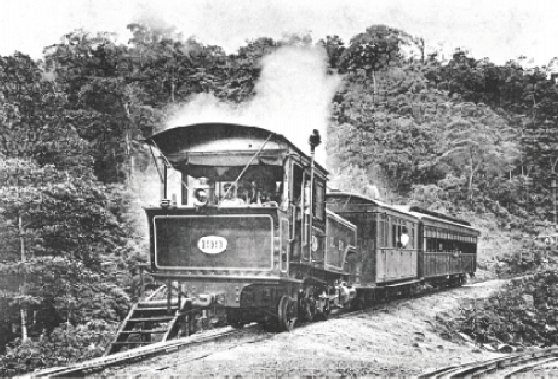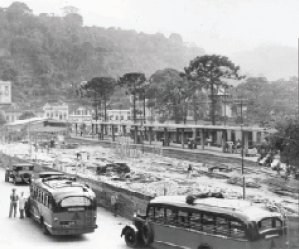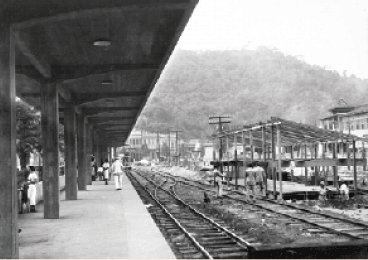Taking the train to Petropolis
In order to escape the Rio de Janeiro heat, each summer we went by train to Petropolis on the former Leopoldina Railway. Sometimes we went to more distant locations. A trip between Rio and Nova Friburgo, for example, took more than double the current two hours. So, my parents normally went to Petropolis during the 1940s. It was much closer to Rio. The trains took an hour and 35 mnutes to two hours to make the run, from Barão de Mauá to Petropolis. Buses took 90 minutes.
 |
| The cog train on a mountain overpass |
Sometimes we stayed longer. My father went to Rio on an “only first class” train that departed at 7:35 a.m. (on the dot!) and was the only one with a dining car. During the 1940s, in the middle of the war and with a lack of oil, this train hauled up to 20 cars. At this size, the steam locomotive found it difficult to get the train underway, with the composition divided into two sections between Petropolis and Alto da Serra. Because of the steam, passengers would wear white overcoats to keep the ashes pouring from the smokestack from smudging their suits.
After saying goodbye to my father and watching the train depart, I waited for the arrival of the heavy “Mineiro Express” (S21-22), which entered the station at 7:28 a.m. coming from Rio de Janeiro, and which went through Petropolis on its way to Ponte Nova, Carangola and Ubá via Porto Novo, according to what was written on the carriages. During school holidays, I hung out at the station for longer hours.
The S21 was the most interesting train because it frequently was the heaviest, and had a unique way of dropping off cars in Petropolis, which I’ll describe later. During the 1940s, it hauled cars containing live poultry, baggage cars full of newspapers, magazines and large, empty steel drums. Then there were one or two second-class cars and at least three first-class cars. The former were for passengers going on to the previously mentioned destinations. Second class passengers normally had to transfer wherever necessary, usually Tres Rios! Moreover, there were cars that remained in Petropolis. Upon leaving for Minas Gerais, the train went backwards, climbing a small ramp that was part of the main line: the cars for Petropolis were uncoupled on the ramp and rolled back into the station after the train departed. The poultry cars went back to Rio a few nights afterwards pulled by S22, now filled with live birds. The steel drums returned to Rio with the S22 containing milk from farms that was picked up along the line.
 |
| Alto da Serra, where one arrived after the 863-meter cog train trip up the mountain |
Sometimes I went down the mountain by bicycle, organizing the trip to be able to pick up Train P11 at Inhomirim to return to Petropolis, bringing the bike as baggage. At the beginning of the 1960s, I would go by car to watch the “Noturno Mineiro” night train (P2/17), which left Rio at 8:10 p.m. and Petropolis at 10:10 p.m., destined alternatively for Caratinga or Manhuaçu (1). There was a stretch after a station called Nogueira, where the train went for a long run alongside the highway. It was pleasant to accompany the puffing of the old Pacific engine that on these days pulled a postal car, some first class carriages, a restaurant and a sleeping car.
the
 |
| The cog engine in the back, pushing the train up the mountain |
My father would return on the 5:30 p.m. train from Rio. The train left from Barão de Mauá, a station built during the 1920s by the then powerful and proud Leopoldina Railway. During the 1940s and 50s the trains were hauled by Pacific-type engines (4-6-2), of English origin. They had a baggage-postal car, a second-class carriage with wooden benches and the oldest cars had flat ceilings! Then followed a variable number of first class cars. These carriages were made of wood, were 12-meters long and had 40 stuffed seats with non-reclining headrests, one window for each pair of seats, a very small bathroom, open balconies at each end and no acoustic insulation. One hour after departing Rio, the train reached Vila Inhomirim. It was a quadruple line between Barão de Mauá and Duque de Caxias, double from there to Saracuruna and then a single track up to Petropolis. The trip time depended upon the number of crossings with other trains.
In Inhomirim, the train was divided into sections. A cog railway engine, each one of which could push two cars up the mountain, substituted the locomotive that came from Rio. A total of 21 cog engines (2), of which seven came from the E.F. Teresopolis that folded in 1957, handled this work.
Puffing mightily, the locomotives went up the mountain on an average grade of some 10º. During the climb, the engines always were behind the train, in order to inhibit the cars from uncoupling and rolling back down the hill. The distance from one section of the train to the next one was very short and signaling was visual. At the entrance of the first car, a conductor would manually signal to the engineer in the rear of the locomotive. Traffic Control authorized the sections of the train to travel in convoys. There was a single crossing yard in the mountain section of the trip, and it was very rarely used. When the train reached Alto da Serra, nearly half an hour later, the engines gave one last push to the cars and they ended up on the main line, while the cog engine was shunted off the line! Today, such a maneuver with passengers still on board would be prohibited.
 |
 |
The old Petropolis train station became a bus station, with only the original marquise surviving (detail) |
|
Petropolis had two stations — one for freight and one for passengers. Another Pacific engine then took the train on to the Petropolis passenger depot in six minutes. This station had two platforms with tracks and another three tracks for maneuvers, along with a water tank for supplying the locomotives. Until the railroad line was abandoned in 1964, steam power was used for the mountain route and local traffic between Alto da Serra and Petropolis.
The deterioration of the railroad began after 1945. The new highways stole passengers and freight from the tracks. The government would not to let the railroad raise its charges enough to cover costs. Maintenance began to worsen, the railroad added 10 minutes to be time necessary to climb the mountain and the trains started to run late. At the beginning of the 1950s, when the trains from Minas were late, extra trains were still put on in Petropolis. In 1953, a Mixed Commission recommended suppression of the cog railway stretches, alleging that they were responsible for 44% of the now-nationalized Leopoldina line’s deficit. Due to the costly operation of the cog stretch, most freight transportation went on an Auxiliary Line, now deactivated. Some 15 buses were used to transport passengers who still went by train, including me!
Shown below is a train timetable typical of the most part of the 1940s and 50s (3).
Very little remains of all of this. Locomotive 327 and two cog engines are preserved (4). One stretch of the railroad line was turned into a street, the Alto da Serra yard became part of a widened highway and the main railroad station became a bus station. Today, times are different; perhaps it was possible to substitute the old trains for automobiles that make the 58 km trip in an hour. But in 1964, only the deficit was noted.
Theodoro Gevert
Transportation Consultant
- In 1962, on Mondays, Wednesdays and Fridays the train ran between Rio-Caratinga; on Tuesdays and Thursdays and Sundays it went from Rio-Manhuaçu; Saturdays it was Rio-Petropolis (see E). The 1962 timetable has some small changes compared to the 1953 timetqble shown above.
- Source: O Vapor nas ferrovias do Brasil, Beníco Guimarães, Editora Gráfica Jornal da Cidade, 1993.
- Source: Guia Levi, December 1953.
- Revista Ferroviaria, August 1996, May 2002.